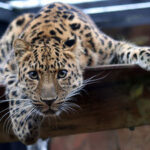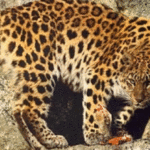The jaguar or Panthera onca is the largest cat in the Western Hemisphere and the third largest in the world, after the tiger and lion. The origin of its name is shrouded in mystery, with no clear etymology. Thanks to early reports, we do know that its name, jaguara, translates to “beast that kills with one leap”. It is also referred to in many areas simply as “el tigre”, or the tiger. The jaguar is a member of the Felidae family, while it belongs to the genus, Panthera, which also includes the leopard, lion and tiger. It is most closely related to the leopard.
Depending on the organization in question, experts say there are between three and nine sub-species of the jaguar. For the purposes of this article, we will limit ourselves to describing regional differences rather than delving into minute physiological inconsistencies.
This magnificent cat is generally from five to six feet long and weighs in anywhere from 80 to nearly 340 pounds. The larger of them are almost equal in size to a tigress. They are compactly built and heavily muscled, making them well suited for hunting in trees, on the ground or in the water. Jaguars have large heads with powerful jaws, enabling them to pierce through the skulls of their prey as well as the shells of turtles and tortoises. Their coats are normally yellow although rust colored, black and even albino is not unheard of. In every case, their coats have large rosettes on them, similar to those of the leopard. In fact, many people have difficulties telling the two breeds apart. However, a keen eye will note that the rosettes of the jaguar have black spots inside them where the leopard has none. In the wild, they can life from 12-15 years and up to 23 years in captivity.
Jaguars can hunt down and eat nearly anything. Their diet includes everything from mice and turtles up to 800 pound cattle. Desperate animals have even been known to eat vegetation, including fruit. Diets normally conform to whatever animal is most prevalent in their hunting area. For example, Brazilian jaguars tend to eat more capybara, dogs and tapir while Peruvian jaguars eat more aquatic animals like caiman and turtles. Jaguars don’t normally chase down their prey, but stalk them instead. Pouncing on their unsuspecting victim, the fight usually ends quickly with a swift bite to the skull. Pound for pound, their bite is more powerful than any other large cat. After killing its prey, jaguars drag their food to a secluded area before eating it. They have been known to drag entire cows up trees.
Although jaguars once roamed large areas of the United States, their current range spans from Mexico through South America. Sightings near the U.S. border are extremely rare today. Their hunting ranges can average from 6 to 60 square miles and they prefer to hunt alone although their hunting areas may overlap with other jaguars. These large cats prefer areas that provide plenty of cover as well as fresh water, although they’ll hunt anywhere if the need arises. Jaguars are a rarity among cats in that they enjoy the water and are excellent swimmers.
Their hunting habits and range size seems to vary with the country they live in. For example, in Belize the average range is from 16 to 24 square miles while Brazilian jaguars have ranges more than double that size. Jaguars will hunt during the day or night, depending on the habits of their prey. Male jaguars tend to avoid others of their kind and are rarely seen with females except during the mating season, yet they will tolerate females in their territory. Most jaguars mark their territory, with the notable exception of the Pantanal region of South America. The natural hunting ranges of the jaguar are shrinking, along with the number of jaguars in general. The cats are now completely gone from El Salvador and Uruguay. The good news is that there are a few protected habitats in Central and South America which allow the animals to hunt freely.
The jaguar sits at the top of its food chain and it is rarely prey upon by other animals, except man. It is considered a keystone species because of its role in maintaining the population of other animals. Due to the difficulty in studying the jaguar, this view isn’t embraced by every scientist. Jaguar numbers have been decreasing for many years, mostly because of human activities. From habitat destruction to over-hunting, man has been the largest threat to these animals.
Female jaguars reach sexual maturity at around 24 months, with males reaching it around three or four years. Mothers normally produce between one and four cubs at birth. Birthing seasons change depending on the region and gestation periods average just over three and a half months. The cubs are blind at birth and weaned by three months. These cubs stay with their mother for up to two years. During this time the mother protects them from everything, even the father.
The future doesn’t look good for the jaguar. As mankind encroaches on their hunting grounds we see more and more clashes between farmers and cats. Another, more insidious fate has been affecting the jaguar in recent years. Pesticides and other agricultural chemicals have been having detrimental effects on newborn cubs, resulting in declining birth rates and increasing birth defects such as blindness. One can only hope that greater efforts by man will help ensure a brighter future for these magnificent hunters.
References
1. “Jaguar (panthera onca)”. Our animals. Akron Zoo.
2. Seymore, K.L. (1989). “Panthera onca”. Mammalian Species 340: 1-9.
3. Wozencraft, W. C. (16 November 2005). in Wilson, D. E., and Reeder, D. M. Mammal Species of the World, 3rd edition, Johns Hopkins University Press.




